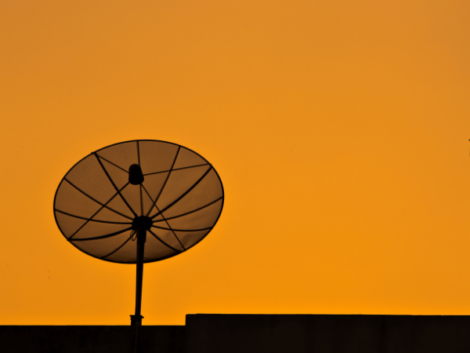How Does Satellite Internet Really Work?
Have you ever been curious about how satellite internet works, or live in a rural area with very poor internet options, own a yacht, or both? New possibilities have begun to emerge, and this is an excellent opportunity for you to gain an internet connection through internet with satellites.
Here’s a quick rundown of what it is exactly and how it functions.
What is Satellite Internet?
Satellite Internet is not a fresh idea, but it is worth it, and popularity seems to be increasing because Elon Musk, Amazon, and several others are trying to increase its qualities and accessibilities.
This is a wonderful idea, as the pandemic has resulted in people working remotely, and they, however, are more dependent on the internet than years before the pandemic.
However, satellite internet is not as fast as cable internet. But in a situation where you need adequate internet infrastructure, like living in a rural area of the country with terrible web reception, on a boat or yacht.
This type of internet connection is when your internet service provider (ISP) gives you internet signals through satellite. It functions by sending a slim fiber of internet signal to a different satellite situated in space. The internet signal then reaches you from space and is picked up by your satellite dish.
Your satellite dish is connected to your satellite modem, connecting your computer to the web. After that, the process connects back to your satellite internet provider, and you are good to go.
This is also similar to how this internet works on boats and yachts, and you can use the satellite to make phone calls, carry out messages, surf the web, and connect HDTV.
How Does Satellite Internet Work?
The working principle of satellite internet is similar to that of satellite TV. Its internet backbone depends on a signal in low earth orbit or high earth orbit. The signal being collected by a receiver dish.
The receiver is often on either the roof of your home or business. Then gaining the most feasible access to an uninterrupted sky.
The signal is then converted into a usable internet connection when your modem is attached to your satellite, supplying your home internet.
While this type of internet needs electricity to function, it does not rely on cable, fiber internet, or phone lines.
These ground station technologies are very expensive to be generated in rural areas, where many organizations have a few customers for the exact amount of cable they invest in.
Sure, launching into geostationary orbit is a daunting task. However, as soon as a good network of people is available, organizations can still offer broadband satellite internet to customers across a large swath of the globe. This is even in very distant locations, once a sufficient network of them is available.
Which Satellite Internet Providers are Available Today?
Viasat and HughesNet are the country’s two leading satellite internet providers, and both have decades of experience in providing this type of internet access. HughesNet just launched its Gen5 service plan for satellite-based residential internet.
Meanwhile, Viasat has begun selling Viasat Flex, a new satellite/DSL hybrid service that promises to increase signal dependability and reduce latency. AT&T’s DSL network serves rural areas. It is offered at no additional cost.
Those two well-known brands are now up against the new, high-profile competition. Amazon’s Project Kuiper, which will deploy thousands of satellites to develop its satellite-based internet service under the Amazon umbrella, was approved by the Federal Communications Commission in July of last year.
Elon Musk, the CEO of SpaceX, is even further ahead. His company’s Starlink satellite internet service already has over a thousand satellites in orbit, and the service is currently in open beta with over 10,000 clients in certain locations. In the video above, you can see our first impressions of Starlink.
Where is the Satellite Internet Available?
Due to the large number of satellites oriented to such latitudes, many locations in the United States can receive satellite transmissions easily.
Take HughesNet, for example. Hughesnet has coverage in all 50 states. Other satellite internet industries are also sorting how to expand their coverage to different parts of the world, including the chance of rural residents having one or more collaborative community hot spots rather than residential dishes and connections.
Is Satellite Service Superior To Other Types Of Internet?
Satellite internet is now capable of speeds comparable to those offered by some of the other prevalent kinds of internet. This is thanks to recent improvements and the abundance of satellites in orbit. If you’re unsure what your current internet speed is, you can check your connection to put the statistics in perspective; the connection is in megabits per second (Mbps).
Cable and DSL internet, for example, are quite prevalent, with DSL download speeds ranging from 3 to 50Mbps and cable speeds ranging from 10 to 500Mbps, depending on your subscription and other factors. Satellite internet is typically 12 to 100Mbps, which is modest, but Musk claims rates of up to 1000Mbps shortly.
Finding a provider that offers satellite internet, requesting a dish be in, and selecting from the available satellite internet plans is quite easy. That is all there is to it.
Because large corporations such as SpaceX and Amazon are entering the business, speeds are to improve and prices to become more competitive; at the very least, availability is expected to expand.
Here’s a breakdown of the advantages and disadvantages of a satellite connection vs. other types of connections.
Pros
It could take a long for broadband internet to be available in your location, and satellite internet is already available. Satellite internet is a straightforward process. As a result, your traffic will take a few more moments to reach outer space. Starlink claims to be installing its satellites significantly closer to Earth to reduce latency.
The dishes, for example, must have a “clean view of the Southern sky,” according to HughesNet. Spottiness or even an outage might be caused by snow accumulation in certain types of weather.
Cons
Besides giving decent broadband download and upload speeds, other solutions will often be less expensive than satellite internet, at least for the time being.
Due to the fact that many satellites are placed in far-off orbits above Earth, latency is a common problem with this form of internet, as your traffic will take a few extra moments to reach its destination.
Satellites typically offer 12 to 100Mbps, which is slow, but Musk claims that once Starlink’s infrastructure is complete, rates of up to 300Mbps will be conceivable.
Fiber internet, which is using fiber-optic cables, may deliver download speeds of up to 2,000Mbps (2 gigabits per second). On the other hand, fiber cable installation is costly, and some places with low population density may not become priority destinations for fiber internet until after satellite internet possibilities have grown.
Myths and Realities about Satellite Internet Service
There are various misconceptions concerning satellite internet. Some are here.
The first myth is that it is extremely slow. However, technological developments and the addition of new satellites have increased speeds. Viasat gives a speed of up to 100 Mbps, and if you go with HughesNet, you can get speeds of up to 25 Mbps. When contemplating, satellite internet gives equal speed to most cable and DSL internet subscriptions, and that’s pretty quick.
The second myth is that it takes a long time to receive signals. There is almost an insignificant difference between the satellite internet and regular Internet. Data usage is faster than with ethernet cable or DSL. Unless you are a gamer, the highest latency of satellites won’t bother you. Latency is the time for data to be sent and received.
The third myth is that the satellite internet is too expensive to manage. Although it is somehow pricey, compared to DSL, Fiber, and cable, the price has dropped in the past decade years, making it a very viable option, especially if any other option is poor or it is your only option.
Viasat package goes for $30 unlimited data per month (no data limits), and HughesNet providers charge more for their internet services for $64.99 per month.
Related Articles
Conclusion
To begin using satellite internet, you must first select a provider after looking at their internet plans. After you’ve decided on a plan, you’ll need to set up an appointment for an installer to come out and get you set up.
The installation of this type of internet normally takes one to four weeks. Installing a specialized satellite dish on your roof requires the services of a licensed technician. After the dish is in, it must be of calibration with an orbiting satellite. This takes only a few hours before it can be of use.
You’ll need to figure out what speeds you need and how much you want to spend, just like you would with any other sort. While it may be tempting to choose the quickest plan, you don’t have to pay for speeds you won’t use.
Selecting a satellite internet package should depend on the activities that you and the rest of your family intend to engage in. Slower speeds are fine for web browsing and email, but faster speeds are good for streaming TV services like Netflix. However, remember that this type of internet may not provide the necessary speeds for 4K or HD streaming.



